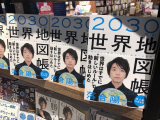2019/12/06 |
Why Yōichi Ochiai Considers the Future to Be Bright |
|---|

Literary Trends in Japan 2019
Digest by Japanese Writers’ House
Yōichi Ochiai is renowned as a man of many talents, having worked as a media artist, researcher, manager, and university educators, which are just a few of his titles. In his new book, 2030 nen no sekai chizu-chō atarashī keizai to SDGs, mirai e no tenbō (The 2030 world atlas: A new economy and SDGs, and future outlook), he explores “the world we live in today” and “the world we are going to live in” through various perspectives including that of technology, the economy, and environment.
A striking example of this is water, one of the most essential parts of our daily lives. Despite a global water shortage crisis, Japan’s abundance of natural water gives it the impression of being generally unconnected to the issue. However, Ochiai says, Japan in fact consumes a large amount of “invisible water” from other countries.
Japan has a low rate of self-sufficiency, and imports most of its food. Clothing is also mostly imported from China and countries in Southeast Asia due to the cheaper costs of production. Due to the colossal quantities of water used in production of food and clothing, it can be said that however indirect this involvement may be, Japan plays a key role in perpetuating the world’s water shortage crisis.
How has the world reached such a critical state, and what can be done about it in the future? While the Ochiai examines the world in a broad sense, it is filled with hints that can help us to think about issues involved in our own personal lives. We normally live day-to-day without thinking about the world as a whole, but there are some things that we only begin to notice when we consider the world’s issues and balance of power. 2030 nen no sekai chizu-chō, with its world facts and maps, helps to illuminate the path to a new global perspective.
Article originally posted in Sinkan JP November 25th 2019
